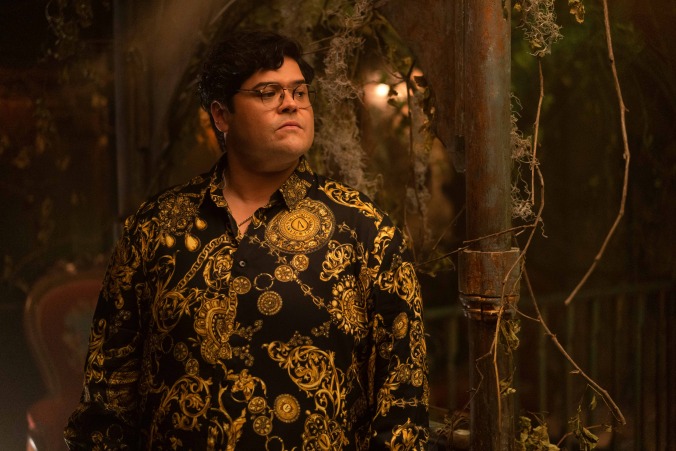How What We Do In The Shadows taps into the inherent queerness of vampires
The fourth season of the FX mockumentary is its queerest yet—and part of a centuries-old tradition

“Gay is in. Gay is hot. I want some gay. Gay it’s gonna be.”
Consider this a mantra, uttered by Matt Berry’s Lazlo Cravensworth in What We Do In The Shadows’ recent episode “Private School,” a line that all but sums up the fourth season of this vampire mockumentary series. While the show has long incorporated elements of queerness within its storylines, this latest batch of episodes has ramped everything up a few notches, really delving into the queerness of its polyamorous household. With its flashes of blatant homoeroticism, What We Do In The Shadows honors a long tradition within vampire lore: the show’s lustful, blood-sucking creatures of the night are part of a storied history of queer readings dating to the inception of the genre.
Twenty-five years before Bram Stoker would release Dracula, Irish author Sheridan Le Fanu came out with the novella Carmilla, featuring the heavily influential and overtly lesbian vampiress Mircalla. One of the first fiction works on vampires, Carmilla lays the groundwork for their nature, homoeroticism included. The tradition of lesbianism in vampire media extends from Dracula’s Daughter (1936) to The Hunger (1983) to the recent Netflix series First Kill (2022). (If you’re thirsting for more queer-vampire recommendations, check out Buffy The Vampire Slayer, The Lost Boys, Only Lovers Left Alive, Jennifer’s Body, Daughters Of Darkness, and The Vampire Lovers—to name a few.)
See, vampires and the erotic have always been intertwined. Bloodlust, desire, and pleasure underline all vampiric tendencies, leaving these undead creatures yearning for the warm, pumping red stuff that us mere mortals hold dear. These creatures of the night satiate their hunger for the life force of the human body, and in essence, the body itself. They are predominantly defined by their desires—material and sexual. To put it plainly, they are beautiful, human-esque beings who use penetration to suck and sometimes exchange blood. This penetration can be performed by any vampire—man or woman—and can be performed on any person, leveling the playing field for any attraction or potential relationship.
What’s more, vampires’ lives outside of human-sanctioned society frees them from the shame cast upon qualities such as queerness, making them the perfect slate to explore these ideas. And going back to the WWDITS household: They perfectly exemplify the concept of a found family existing away from “our” world, which offers a space for unconditional acceptance, understanding, and—when it comes to queerness—mutual respect.
So yes, all in all, vampires are … sexy and gay! They align themselves with the night where they pursue all of their non-beating heart’s hedonistic desires. As Lazlo puts it: “I became a vampire to suck blood and fuck forever.”
Since the beginning, it’s been clear that the vampires of What We Do In The Shadows—that’s Lazlo, Nadja (Natasia Demetriou), and Nandor the Relentless (Kayvan Novak)—all share queer tendencies. Come on, they’ve lived in a house together for ages. It would be more unbelievable if they hadn’t all had sex with each other at this point.
Lazlo’s queerness was established in the pilot, when he confessed to having a sexual affair with the pre-toasted Baron Afanas (Doug Jones). Then in season two, episode nine of the series, Nandor and Lazlo nonchalantly engage in their own sexual tryst, hopped up on witches’ viagra. While Nadja’s queerness has been more implicitly expressed in remarks, such as in the latest episode, “Pine Barrens,” when she scoffs, “I mean, who isn’t gay?” (Colin Robinson, meanwhile, will mostly be absent from this conversation, as right now he exists in the form of a child who only cares about musical theater and Roblox, despite his own previous flashes of queer expression.)
But this season, everything is more front and center. We see Nandor begin his adamant Bachelor-style search for a wife—which by his definition progressively means a man or woman. While he ends up settling on marrying Marwa out of his 37 previous wives (including three Dalals), we see Nandor show interest in wives of all genders. When his wedding to someone who’s not Guillermo finally comes around in episode six, the Djinn (Anoop Desai) lays the groundwork for an even deeper queer longing when Nandor brainwashes Marwa to like all the things he does—which makes her like Guillermo a lot. All the while, Lazlo peruses the wedding guests for one quick fuck with the Baron, now restored to his former glory.
All of this leads to the moment that familiar-turned-bodyguard-turned-accountant Guillermo (Harvey Guillén) not only comes out to his visiting family as gay but as someone who wants to become a vampire. While Guillermo’s been a queer-coded character from the get-go (starting with his obsession with Interview With The Vampire), “Pine Barrens” marks the first time he officially comes out. This synchronous confessional makes sense, as Guillermo asserts his full desires as a human to his Van Helsing-derived family, who can readily accept him being gay but not his wishes of becoming a vampire. Here, queerness and vampirism collide, expressing the need for belonging, visibility, and deep, foreboding desire.
With the series renewed for at least two more seasons (and with a few episodes left in this one), hopefully we will continuously see Lazlo, Nandor, Nadja, and Guillermo’s queerness examined and emboldened—especially Nadja, who really deserves her own Carmilla moment. Fingers crossed.